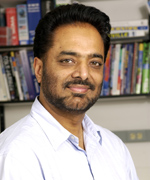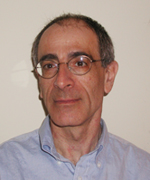Three NIH Scientists Elected to the National Academy of Sciences
Carolina Barillas-Mury (NIAID), Shiv Grewal (NCI), Marius Clore (NIDDK)
Whether they are investigating mosquito midgut cells to better understand the transmission of malaria, identifying failing chromatin mechanisms that may lead to cancer, or exploring the structure of macromolecular “dark matter,” the newest NIH members of the National Academy of Sciences (NAS) are making a big impact. On April 29, the NAS announced the election of 84 new members, including three NIH scientists: Carolina Barillas-Mury (National Institute of Allergy and Infectious Diseases, NIAID), Shiv Grewal (National Cancer Institute, NCI), and Marius Clore (National Institute of Diabetes and Digestive and Kidney Diseases, NIDDK). The three scientists shared their research at an NIH minisymposium held in Masur Auditorium (Building 10) in June.
Carolina Barillas-Mury’s “discoveries have revolutionized our understanding of mosquito immune defenses,” said NIAID Senior Investigator Tom Wellems—also an NAS member—as he introduced her at the symposium.

Carolina Barillas-Mury, NIAID
Typically, when a mosquito feeds on the blood of a malaria-infected person or animal, malaria parasites enter the mosquito’s gut and are later transmitted to the mosquito’s next unsuspecting host. Barillas-Mury, who is a section chief in NIAID’s Laboratory of Malaria and Vector Research, has shown that the mosquito’s immune system can learn to fight off malaria-causing parasites.
“Imagine we’re all sitting inside a midgut mosquito cell,” Barillas-Mury began. She pointed to a set of double doors on one side of the auditorium and asked the audience to picture a parasite entering. If it tripped the alarm, a security system would spray it with yellow paint. Then when it tried to escape through the opposite set of doors, it could be easily identified and stopped. But any parasite that could avoid being tagged would avoid the detection system and escape unharmed.
It turns out that previous exposure to the parasite results in more sentinel cells that help the mosquito immune system learn to fight the invaders. Barillas-Mury hopes that her work might pave the way for preventing malaria infections by making mosquitoes malaria-proof.
She also hopes her election to the NAS will pave the way for other Hispanic and women scientists to be successful. She joked that although she loves her home country, Guatemala—and visits her 80-year-old mother there twice a year—dreaming of becoming a research scientist was “like saying you’re going to be an astronaut in a country without a space program.” She knew she had to leave to accomplish her professional dream. When she received the news that she had been elected to the NAS, the culmination of that dream, the first thing she did was call her mother.
The first thing Shiv Grewal did when he got the news about his election to NAS was to think of his father, who was also a scientist. Sadly, he had passed away when Grewal was young. “He would understand what this means,” Grewal said. He was driving to work when he got the news and had to pull over to take the call. The same week, he also learned that he had been elected to the prestigious American Academy of Arts and Sciences.

Shiv Grewal, NCI
As an NIH Distinguished Investigator and chief of NCI’s Laboratory of Biochemistry and Molecular Biology, Grewal studies how eukaryotic genomic information is organized into distinct chromatin domains, what the molecular architecture and mechanisms of these domains are, and how genetic mutations can have deleterious consequences, including cancer. In particular, his lab is focused on RNA-based targeting of chromatin modifiers akin to an “on/off” switch for reading and expressing the genome. Grewal is using a technique called high-throughput chromosome capture to examine the role of heterochromatin in organizing DNA inside a cell’s nucleus.
“The NIH has always been the place to do chromatin research,” said Grewal, who has come full circle since starting his career at NIH. When he was doing his postdoctoral research at NCI, he demonstrated epigenetic control of gene expression. Later, in 2002, his defining the important role of RNA interference in histone-modification patterns was named Science’s breakthrough of the year.
“Define your scientific question early on,” Grewall offered as advice to young scientists. “After your graduate work, pick a core key question, build a system, and dedicate yourself.”
NIDDK Distinguished Investigator Marius Clore—who has been at NIH since 1988, is section chief in NIDDK’s Laboratory of Chemical Physics, and is also a member of the American Academy—has dedicated himself to using nuclear magnetic resonance spectroscopy (NMR) to examine proteins.

Marius Clore, NIDDK
“Marius Clore is a true pioneer in developing NMR into the powerful tool it is today for studying the structure, dynamics, and interactions of proteins,” said NIDDK Scientific Director Michael Krause at the symposium.
Clore is using a specialized NMR method called paramagnetic relaxation enhancement (PRE) to decipher what he calls “dark matter”—all the mysterious properties of protein-protein, protein-DNA, and protein-ligand recognition. PRE is a technique that allows for measuring longer distances between labeled atomic nuclei, to detect and study the mechanisms of sparse and transient macromolecular interactions.
Clore also advised young scientists to dedicate themselves to their work. “Whatever you’re doing, do it 100 percent,” he said. He gives 100 percent to his extracurricular pursuits, too: He has a third-degree black belt in taekwondo and is an avid cyclist. One of his proudest achievements was conquering La Marmotte, a 108-mile bike race winding through the French Alps with nearly 17,000 feet of elevation.
Barillas-Mury, Grewal, and Clore represent the “extraordinary richness of talent at the NIH,” Michael Gottesman, deputy director for intramural research, told the NIHers gathered for the symposium. The three now join the 55 other NIH intramural scientists who are NAS members.
Several NIHers are elected to the NAS each year. The list is posted at https://irp.nih.gov/about-us/honors/the-national-academies. The NAS lecture is scheduled to be an annual event.
This page was last updated on Tuesday, April 26, 2022
